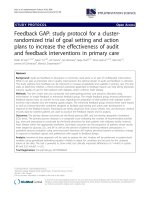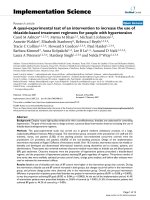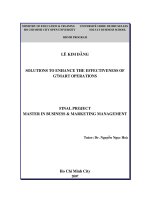Solutions to improve marketing communication to increase brand recognition of VICHI
Bạn đang xem bản rút gọn của tài liệu. Xem và tải ngay bản đầy đủ của tài liệu tại đây (713.15 KB, 92 trang )
ACADEMY OF POLICY AND DEVELOPMENT INTERNATIONAL
SCHOOL OF ECONOMICS AND FINANCE
SENIOR THESIS
Global marketing communications to improve brand
recognition of VICHI
Instructor:
Mrs. Nguyen Thi Bich Ngoc
Student:
Bui Thi Hong Ngoc
Student ID:
5073106024
Class:
KTDNCLC 7A
ACADEMY OF POLICY AND DEVELOPMENT INTERNATIONAL
SCHOOL OF ECONOMICS AND FINANCE
SENIOR THESIS
Global marketing communications to improve brand
recognition of VICHI
Instructor:
Mrs. Nguyen Thi Bich Ngoc
Student:
Bui Thi Hong Ngoc
Student ID:
5073106024
Class:
KTDNCLC 7A
ACKNOWLEDGE
To complete successfully my graduation thesis, I would like to express my
gratitude to Mr. Pham Hoang Cuong and Mrs. Nguyen Thi Bich Ngoc, who
whole-hearted guided throughout the process of writing this senior thesis.
I would like to express my sincere thanks to the teachers and students in
the I.S.E.F, Academy of Policy and Development for their dedication to
imparting knowledge during the years I have studied. With the knowledge gained
in the learning process, it is not only a foundation for the thesis research process
but also a valuable tool for me to enter the life in a firm and confident manner.
I would like to sincerely thank the Board of Directors of TAME CO., LTD
for allowing and creating favorable conditions for me to practice at the company.
I would like to thank the company's marketing department for helping me
understand the importance as well as the necessity and complexity of marketing
in the business, especially the importance of marketing communications.
Finally, I would like to wish all of you the teachers and students good
health and success in their noble careers, good health, and great success in their
work.
Because my knowledge is limited, in the process of practicing and
perfecting this topic, I cannot avoid mistakes, I hope to receive suggestions from
you and your company.
ACKNOWLEDGE......................................................................................1
INTRODUCTION.......................................................................................1
CHAPTER I: OVERVIEW OF MARKETING COMMUNICATION.......3
1.1. Marketing overview......................................................................3
1.1.1. General concept of marketing........................................... 3
1.1.2. The role and function of marketing................................... 4
1.2. Overview of marketing communications:.................................... 6
1.2.1. Concept of marketing communication:..............................6
1.2.2. The role of marketing communications:............................6
1.2.3. Marketing communication tools:.......................................7
1.3. Marketing communication planning process:.............................14
1.3.1. Identify the target audience group:..................................14
1.3.2. Define communication goals:..........................................14
1.3.3. Design messages:............................................................ 18
1.3.4. Choice of media:..............................................................20
1.3.5. Determine media budget..................................................22
1.3.6. Evaluation of results - test communication activities......24
1.4. Factors affecting the implementation of the marketing
communication strategy:..............................................................................25
1.4.1. Micro environment:......................................................... 26
1.4.2. Macro environment:.........................................................29
1.5.
Criteria
to
evaluate
the
effectiveness
of
marketing
communication activities.............................................................................31
1.5.1. Match the media budget.................................................. 32
1.5.2. Target customer awareness level..................................... 32
1.5.3. Determine the outcome measures....................................33
1.5.4. Compare performance with set standards.......................34
1.5.5. Take the appropriate action.............................................34
1.5.6. Some methods of evaluating communication effectiveness
35
1.6. Overview of brand awareness communication...........................36
1.6.1. Mode of operation........................................................... 36
1.6.2. Special Considerations Regarding Brand Awareness.....37
1.6.3. Other Ways to Create Brand Awareness..........................37
CHAPTER II: Actual situation of communication marketing activities of
TAME's VICHI cream products...........................................................................39
2.1. Overview of TAME CO., LTD:.................................................. 39
2.1.1. The process of formation and development of TAME CO.,
LTD:.................................................................................................... 39
2.1.2. The organizational structure of TAME CO., LTD:..........40
2.1.3. Business field and development orientation:...................43
2.2. The production and business situation of TAME:......................45
2.2.1.VICHI product introduction..............................................45
2.2.2.VICHI's business results in 2years 2019-2020.................46
2.3. Marketing activities for VICHI products at Tame Vietnam Co.,
Ltd:.............................................................................................................. 50
2.3.1.Target market:...................................................................50
2.3.2.Marketing activities for VICHI cream products at TAME
Vietnam:...............................................................................................51
2.4. Current status of marketing communication for VICHI cream
products of TAME CO., LTD.......................................................................56
2.4.1.The company's target audience:....................................... 56
2.4.2.Communication goals:......................................................57
2.4.3.Company message:...........................................................58
2.4.4.Media that the company is using:.....................................60
2.5. Evaluate the effectiveness of the company's communication
activities: 63
2.5.1.Results achieved:..............................................................63
2.5.2.Limitations:.......................................................................66
2.5.3.Evaluating the cause:....................................................... 69
CHAPTER III: Some marketing solutions to improve the efficiency of
communication activities of TAME CO., LTD....................................................70
3.1. Basis for choosing marketing solutions to improve the
effectiveness of TAME's communication activities:....................................70
3.1.1.Industry development trends:........................................... 70
3.1.2.SWOT analysis..................................................................71
3.1.2.1.Strengths:.......................................................................71
3.1.2.2.Weaknesses:...................................................................72
3.1.2.3.Opportunity:.................................................................. 72
3.1.2.4.Threat:........................................................................... 73
3.2. Some
marketing
solutions
to
improve
the
communication
efficiency of TAME CO., LTD:................................................................... 74
3.2.1.Solutions related to marketing communication planning: 74
3.2.1.1.Identify the target audience........................................... 74
3.2.1.2.Define communication goals......................................... 75
3.2.1.3.Media message.............................................................. 75
3.2.2.Solutions related to communication tools:....................... 75
3.2.2.1.Advertisement................................................................ 75
3.2.2.2.Public Relations 76
3.2.2.3.Direct marketing 77
3.2.3.Other solutions
78
3.2.3.1.About the product 78
3.2.3.2.About price78
3.2.3.3.About distribution channel
79
3.2.4. Some recommendations:..........................................................80
3.2.4.1.With TAME CO., LTD: 80
3.2.4.2.With the state
81
3.2.5.With foreign markets for VICHI’s product
81
CONCLUSION......................................................................................... 83
REFERENCES.......................................................................................... 84
INTRODUCTION
1. Rationale:
The economy is developing day by day, living standards are increasing,
especially the open market mechanism has created favorable conditions for
businesses to participate in this potential market. These are the opportunities and
challenges for businesses to assert themselves and find their strong foothold in
the market, but at the same time, face many difficulties. For pharmaceutical
products when the customer's ability to trust drug quality is not high, building a
marketing communication campaign to create a desired image in the customer is
an important tool in competition in this industry. Aware of this issue, along with
the enthusiastic guidance of Lecturer Nguyen Thi Bich Ngoc, I focused on
researching the topic "Solutions to improve marketing communication to
increase brand recognition of VICHI” for my graduation thesis.
2. Research objectives:
Research overview of marketing communication, analyze and evaluate the
current status of marketing communication activities of TAME CO., LTD from
there will propose some ideas to improve the effectiveness of marketing
communication for the product " VICHI cream "of TAME CO., LTD in the
period 2021 - 2022.
3. Research subjects:
The research object of the graduation thesis is marketing communication
activities for VICHI cream products at TAME CO., LTD.
4.
-
Scope of research:
Content: Researching the current status of marketing activities and
communication activities of TAME CO., LTD, researching on solutions to
improve the efficiency of communication activities of the company
1
- Space: TAME CO., LTD.
- Time: Basing on three-year data from 2018 to 2020.
5.
Research Methodology:
Applying the method of synthesis, analysis, and theoretical comparison
with practice. To increase persuasion of my thesis, I have used a number of
diagrams and tables.
6. The structure of the thesis:
In addition to the Introduction and Conclusion, the thesis includes 3 parts:
Chapter I: Overview of marketing communication.
Chapter II: Actual situation of communication marketing activities of
TAME's VICHI cream products.
Chapter III: Some marketing solutions to improve the efficiency of
communication activities of TAME CO., LTD.
2
CHAPTER I: OVERVIEW OF MARKETING COMMUNICATION
1.1. Marketing overview
1.1.1. General concept of marketing
The term "Marketing" was first used in 1902 in the lecture halls of the
University of Michigan in America. Up to now, along with the non-stop
development of human civilization, the term "Marketing" has also undergone
constant changes and diversification. The appearance of many concepts of
marketing in the business field as well as many other fields such as politics,
culture, sports, science... has proved this.
According to Phillip Kotler - a famous American marketing professor, has
defined that: "Marketing is a form of human activity to satisfy their needs and
wants through communication processes."
(Source: Philip Kotler (1994), Marketing Management, Statistical
Publishing House)
However, in order to match the different business conditions at each stage
of economic development, in 2007, the American Marketing Association
introduced new definitions of marketing as follows: “Marketing is a collection of
activities and structure mechanisms and processes to create, communicate and
deliver things of value to consumers, customers, partners and society at large. "
At the same time, according to the opinion of Professor Dr. Tran Minh
Dao: “Marketing is not only a business management function, but it covers
business activities from discovering purchasing power and transforming the
purchasing power of consumers into the real demand for a particular product, to
3
bringing that goods to the final consumption place in order to ensure the highest
profit for the business."
(Source: Tran Minh Dao, Basic Marketing, National
Economics University Publisher).
Although there are many different definitions of marketing due to the
different views and perspectives on marketing problems of each individual or
organization, in general, marketing can be seen as a social process by which
organizations or individuals satisfy their needs and wants by creating and
exchanging valuable knowledge with others. Therefore, the scientific research of
marketing and applying it into practice is very necessary for the success of
businesses today…
1.1.2. The role and function of marketing
1.1.2.1. The role of marketing:
Marketing not only plays an important role for businesses but also for
consumers as well as society, it has created the interests of stakeholders and
linked together to form a unified block. Marketing is the bridge between
customers and businesses through which businesses can ensure their production
and business activities according to customers so that eventually the business can
achieve its goal of getting revenue and high profit. At the same time, marketing
provides the changing conditions of the economy, helping businesses survive and
grow more and more sustainably.
1.1.2.2. The function of marketing:
Marketing activities in the business play a decisive role in the company's
position in the market. Starting from market research, cataloging to the
implementation of production and distribution, and when the goods are sold,
4
operations continue, so the marketing management function is closely related to
the Other areas of management in the business and it has a role of orientation,
combining other functions to not adjust to attract customers but also find
effective tools that satisfy customers' needs and bring profit for company.
In general, the marketing function in the business always shows the
following basic contents:
Who are your customers? Where do they buy? How much do they buy?
How do they buy? Why do they buy?
What kind of goods do they need? What are the characteristics of that
commodity? Why do they need that and not another? Are the current
characteristics of the good still relevant for the good?
What are the advantages and disadvantages of goods of the enterprise? Is
there a need to change? Which properties need to change? What if I don't
change? What will happen if we change?
How should the price of the goods be and how much? Why set a price
like that and not another price? Is the previous price still appropriate? Should
increase or decrease? How much increase or decrease, when is appropriate?
Change with which customers, which goods?
Should businesses organize their sales by themselves or rely on other
intermediaries? When to bring goods to market? How much volume put? - How
do customers know, buy and love the products of the business? Why should we
use one method and not another? Do your goods need after-sales service? What
kind of services are you most likely to provide? Why? Why do businesses choose
this type of service over another? ... That is the problem that other than the
marketing function no function can answer.
5
In short, the marketing function plays a very important role and is one of
the four indispensable functions of the business (production function, financial
function, human resource management function, and marketing function). This
requires businesses to pay attention to developing the marketing function if they
want to survive and grow…
1.2. Overview of marketing communications:
1.2.1. Concept of marketing communication:
According to Philip Kotler: “Marketing communication is the activities of
indirectly or directly communicating information about the product and the
business itself to the customer in order to convince them to trust the business as
well as the product. , and buy products from the business ”.
(Source: Philip Kotler (1994), Marketing Management, Statistical
Publishing House)
Marketing communication has the basic purposes of informing, convincing
and reminding the audience about the products and brands of the business.
Through the message content, the business informs customers of the presence of
the business or the product in the market, convinces them of the advantages of
the product compared to competing products, and reminds them remember the
product when the need arises.
1.2.2. The role of marketing communications:
Marketing communication is an important element that plays an important
role in supporting other marketing - mix strategies. Other well-developed
marketing strategies and tactics will help reduce communication activity.
However, there are very few services, mainly those provided in a competitive 6
environment that can ignore the role of marketing communications. In addition,
today the product life cycle is shorter and shorter, so the viewpoint “Good wine
needs no bush” is no longer relevant.
Through marketing communication activities, businesses inform potential
customers about the advantages, uses, values and benefits of products to
consumers. Therefore, marketing communication helps businesses increase sales
of existing products, create customer awareness and preference for new products,
and build a good image of the business. However, businesses need to combine
their communication strategy with other elements of the marketing mix to create
synergistic effects. Communication also helps businesses to promote their
brands.
1.2.3. Marketing communication tools:
To choose the optimal media, companies must carefully study 5 tools of
communication activities as follows: Advertising, Public Relations, Promotion,
Direct Selling, Direct Marketing, Then the company will find ways to achieve
efficiency by replacing one promotion tool for another until a certain level of
savings is reached. Businesses can use independent communication tools when
they set out communication goals. Conversely, for enterprises that offer many
activities for the communication process, it is possible to conduct coordinated
communication activities.
1.2.3.1. Advertising:
“Advertising is any presence of any kind of goods, services, intentions,
ideas… acting through the mass media for which one has to pay to identify
people advertisement.”
(Source: American Marketing Association)
7
Advertising is the attempt to influence the buying behavior and habits of
consumers by providing convincing sales messages about a seller's product or
service.
Advertising plays an important role in today's highly competitive world
and at the same time it is facing the challenges as more and more ad units open
up every day. Advertising is a means of information that also influences the
public to buy certain products or services through images or conveyed by
messages. A product or service is advertised to draw interest, attention, and
awareness in the minds of your current customers (buyers) and potential
customers. The advertising industry's social trend changes have seen rapid
development.
Some media are commonly used for advertising such as television, radio,
websites, newspapers, magazines, signs, advertising panels...
Advertising on TV: is the means of impact to the most diverse and
comprehensive consumers, with sound and vivid images. This form of cost is the
most expensive that sometimes indirectly by sponsoring shows, or with
advertising logos.
Advertising on the Internet: As information technology and the internet
develop, the type of online newspaper also develops so companies often exploit
this medium. It can also be sent to email boxes to advertise, or to film
advertisements on websites. Today, the internet is very popular to many families,
which is an advantage for businesses to exploit brand advertising in networks on
the internet.
Advertising on means of transport: is a form of painting products and
company names on the sides of vehicles, especially buses with a large area and a
lot of passengers per day. People often use buses as a means of advertising for
8
products with a long lifespan or brand of the whole company, not introducing
short, fast outdated products.
Advertising at the point of purchase: is the form in which the seller will
introduce the features and features of the product at the place where he / she
supplies the product to the customer. This method is cost-free, can cause
curiosity and attract customers to use the product.
1.2.3.2. Public Relations:
"Public relations is a form of non-personal communication about an
organization, product, service or idea that the subject does not have to pay
directly."
The public can facilitate or hinder a company from achieving its goals. A
wise company must take concrete steps to address key public relations. Public
relations is to monitor public attitudes of information distribution organizations
and to communicate to build credibility. When bad public opinion occurs, there
must be arrangements to create good social opinion about those negative rumors
and images. The main activities of public relations:
Media relations: to post valuable information on the mass media to
attract attention to a person, product, or translation department or organization.
Product propaganda: Various attempts to make claims about specific products.
Corporate communications: including internal and external media to
deepen the understanding of the company
Lobbying: working with legislators and government officials government
to promote or repeal a law or regulation
1.2.3.3. Sale promotion (Promotion):
9
"Sales promotion or promotion is short-term immediate measures that
encourage an immediate trial or purchase of a product or service or to buy
more."
Selling promotion has a direct and positive effect on sales growth by
providing additional physical benefits to buyers, which can be bonuses,
discounts, and prizes. Advertising does not mean that consumers will have an
immediate buying response, so sales promotion activities will support
advertising activities to encourage, motivate and motivate them to move towards
faster buying action.
The main purpose of promotions is to stimulate consumer demand, to
motivate consumers to buy and buy more goods or services that the business
provides or distributes. For distribution intermediaries: encourage this
distribution force to increase distribution activities, promote sales activities,
consolidate and expand distribution channels, exercise market reserve, normal
distribution constantly to expand the market.
There are a variety of different stimulus tools available to accomplish this
goal. Promotion tools can be divided into the following groups:
The group of tools that generate economic benefits that directly push
consumption includes:
For example, samples, gift certificates, generic goods, gifts.
Samples have a function to encourage trial use. Samples can be distributed
in the store or sent to home by mail or a couple of marketing staff.
Voucher is a certificate for customers to receive a certain amount
reduction when buying a certain volume of goods from the business. A
generic package is a package that a business introduces a number of goods
to be sold at low prices.
1
A gift is a gift or sale at a discount. Gifts are usually distributed
with a purchase.
Group of tools to promote activities of intermediaries in distribution
channels:
Manufacturers will finance their purchases, which is the amount of
money that is reduced on the purchase of the business for a certain time.
Advertising sponsorship, advertisers sponsored to encourage them
to introduce company products.
Free merchandise is a bonus to dealers when they purchase a
certain amount.
Customer conferences, fairs and exhibitions: Businesses often
organize customers to help businesses reach customers, learn more
thoroughly their needs and get feedback.
Display products at the place of sale, use recommended stores.
Showcase and sell products.
Contests and games: give customers, distributors or sellers an
opportunity to receive a material benefit.
1.2.3.4. Personal Sales:
“Selling is a form of direct oral introduction about goods and services
through the exchange and conversation with potential buyers to sell goods. It is
a process in which the seller learns, explores, evokes, and responds to the needs
and wants of the customer in order to achieve the satisfactory, long-term
interests of both parties.”
Using personal sales has its own advantages because customers can better
understand the product. When the sales team is highly qualified, customers will
receive clear instructions on how to use them correctly as well as fully and
1
convincingly demonstrate the value of the product. In addition, through sales
activities, employees can obtain customer information about products,
companies and competitors accurately and quickly.
Basically, the sales process consists of the following steps:
Exploration and evaluation: The company provides information about
the buyer, the seller contacts with customers and identifies potential customers
from there develop relationships with those customers.
Prior-contact: sellers need to know the company, its potential customers,
and its buyers as detailed as possible.
Contact: salespeople must know how to contact and invite buyers to have
a good initial relationship. Sellers need to analyze to understand buyers' needs,
answer key questions and pay close attention to learn and listen to customer
needs.
Introduce and demonstrate: salespeople presenting products to buyers in
accordance with the laws of media awareness in order to gain attention, maintain
interest, encourage desire and get action.
Handling of rejection: customers almost always refuse, psychological
rejection because customers do not want to be disturbed, prefer familiar brands,
do not like to give up love, objections about the price, characteristics of the
product. To understand the objection, it is possible to ask a question for the buyer
to answer his / her protest and make it one of the reasons for the purchase.
Tracking: this is the last and very important step towards testing customer
satisfaction ratings and their likelihood of repeat purchases. Immediately after
selling, employees must advise the necessary information for customers, a
tracking schedule when having the first order. After-sales care
1
strengthens the relationship, limits the customer's usage risks and maintains
potential purchasing power.
1.2.3.5. Direct marketing:
“Direct marketing is a way of using media so that organizations can
communicate directly with target customers to generate customer feedback or
transactions at any location.”
Today, direct marketing plays an increasingly important and growing role
in promotional tools. These direct marketers use direct response advertising to
sell and learn about a customer whose name and expertise has been entered into
the customer database to establish a relationship more frequently and richer. The
main tools of direct marketing are:
Marketing by leaflets, catalogs: businesses send leaflets, catalogs to
potential customers, based on these leaflets, catalogs, customers will place orders
with the company according to the products in the leaflets, catalogs.
Direct mail marketing: the company sends sales letters, brochures,
leaflets and other forms of offers to customers. Thereby, the company hopes to
sell products or services, collect or select a list of customers for the sales force,
announce information or send gifts to thank customers.
Phone marketing: companies use phones to make direct deals to select
customers. The company can also order a toll-free number for customers to order
products they know through television advertisements, flyers, catalogs or to
make complaints and suggestions with businesses.
Computer marketing: customers buy goods through a computer
connected to the network, place orders, and pay directly through the internet.
Direct marketing has been used by manufacturers and retailers, businesses
and services. Direct marketing brings many benefits to customers, allows more
1
selective prospects, more accurate access time, and keeps marketing activities
secret from competitors.
1.3. Marketing communication planning process:
In order to organize communication effectively, businesses need to
understand how communication works, how to organize a communication
campaign, and must understand the basic elements of the communication process
information in the strategy that the business has made. A campaign is done
through the following basic steps:
1.3.1. Identify the target audience group:
The public is a group of people, both internal and external, to which an
organization is related. The communicator wants to carry out the communication
work, first of all, must clearly define who is the target audience. For a business,
the public can be either potential customers or existing users, decision makers or
people who have an impact on it. The public to which a business is directed can
be an individual, a group, a special public or the general public. The target public
group will have a strong influence on the media's decisions about issues such as:
what to say, how to say, when, where and to whom.
1.3.2. Define communication goals:
Once the target audience and its characteristics have been identified, the
marketing communicator must decide on which response to the public's wishes.
Responding, of course, is to make customer buy and be satisfied. But buying
behavior is the end result of a very long consumer decision-making process. The
1
marketer needs to know how to get the target public to a higher willingness to
buy state.
Marketers can search the public for a target in response to perception,
perception or behavior. This means that marketers may want to inculcate in the
consumer's mind something to change their attitudes or motivate them to act.
In marketing, defining a specific goal is a prerequisite requirement to be
able to develop a suitable strategy to achieve that goal. Specific goals help
marketers measure the effectiveness of the implementation of their marketing
strategy. Marketers can apply SMART principles to achieve their goals. The
SMART principle means:
Specific - specific, easy to understand: The goal must be specific as it
guides future activities.
Measurable - Measurable: A given target must have a specific unit and
number that can be measured.
Achievable - fit: A goal must be challenging to try, but don't set an
unattainable target either.
Realistic - reality: This is the criterion that measures the balance between
the performance and the resources of your business (time, personnel, money...).
Deadline: All work must have a deadline, otherwise it will be delayed.
Having the right time helps you both achieve your goals while nurturing your
other goals.
Another chain is "behavior - perception - perception", when the public
pays a lot of attention, but is aware of little or no perception of a difference in the
product category, like when buying a bottle of water pure. There is a third chain
is "perception - behavior - perception", when the public pays little attention and
awareness has little difference in product type, like when buying salt. When
1
understanding the right chain, marketers can better perform communication
planning...
Table 1.1. Consumer response patterns
Paradigm
Stage
Cognitive stage
Sensory stage
Behavioral stage
(Source: www.voer.edu.vn)
Here we will assume that the buyer is very attentive to the type of product
and is aware of the differences in that product category. So we will use the
"degree of efficiency" model (cognitive, sensory, behavior) and describe the six
buyer readiness states - awareness, knowledge, liking, preference, conviction,
and purchase.
1
Awareness: The communicator must first know how the target public
knows the product or their organization. If the majority of them do not know
anything about the business or its products, it is the communicator's job to let
them know, at least the name of the business. This can be done with a simple
message repeating this name. However, giving the public simple information also
takes time.
Knowledge: The target public may know about a product or a business
but may not yet really understand them. Getting the public to understand the
business and its products is the communicator's next goal.
Liking: If the public already understands the product, will they feel about
it? If the public does not show sympathy for the product, the business needs to
launch a media campaign to build sympathy. And if this does not work because
the product still has many defects, the business must first find ways to improve
the product. Public relations require "good action precedes good words".
Preference: The target public may like the product but dislike it over the
other products. In this case it is necessary to promote product outstanding
features such as price, quality and other features in order to convince the public
and increase their product popularity.
Conviction: A target public may be interested in a product but not sure
that he will buy it. The communicator's job is to establish a firm belief that the
product purchase decision was correct.
Purchase: Some of the target public may already believe, but not
necessarily immediately consider buying. They may wait for more information,
or plan to do so later. The communicator must lead these leads to the final step of
buying.
1
The above six states are gathered in three phases: perception (knowledge,
awareness), feeling (liking, preference and conviction), and behavior
(purchasing). The consumer could be in any of the six ready to buy states. It is
the job of the communicator to determine what stage the majority of consumers
are at, and to launch a communication campaign to take them to the next stage.
1.3.3. Design messages:
Once a buyer's desired response has been determined, then designed an
effective message. Creating a message will require solving four problems: what
to say (the content of the message), how to say it logically (the message
structure), how to say expressive (the form of the message). and who speaks
convincingly (source of the message).
Communication messages are the points that attract the attention of
customers, tell customers how businesses can solve their problems, why they
should trust the business, and why they should choose this business over other
site competitors. A transmitted message needs to be received and understood
correctly. The key to creating an effective communication message is making
sure it fits the needs and wants of your customers. Typically, building a message
takes five basic steps:
Step 1: Identify your target market. Every successful business has a target
market. Therefore, the first step, it is necessary to define "who the target market
is". Once narrowed, the message will be closer to that segment of the market.
Step 2: Define the content of the message. The communicator must
envision what will be telling the public the target to create the desired response.
This process is referred to in different ways as drafting an invitation, topic or
idea. The bottom line is to outline some of the benefits, motivations,
1









